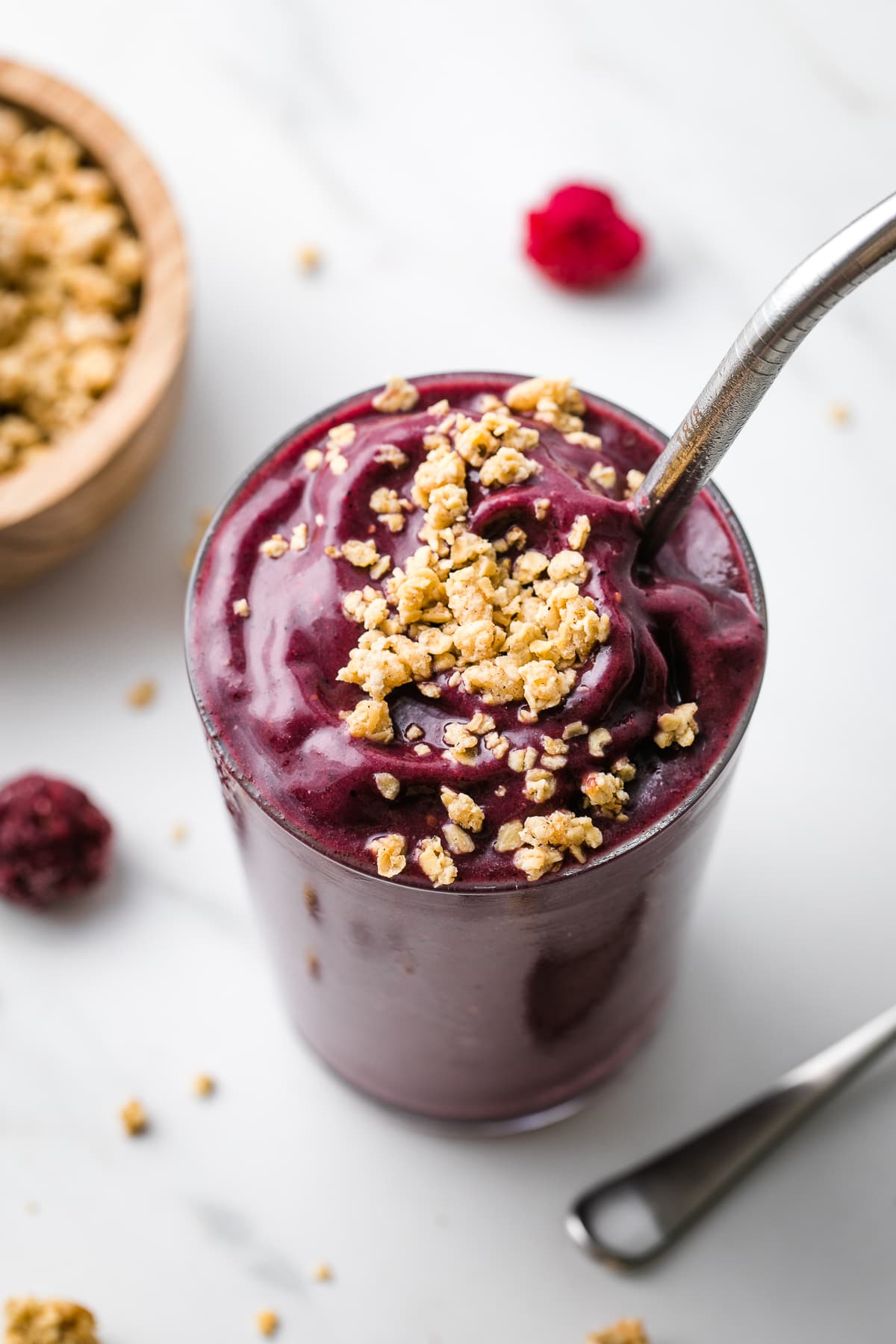Smoothies and protein shakes can be a convenient and nutrient-packed option—especially on busy days. But for many people, they come with a not-so-smooth side effect: bloating.
If you’ve ever made what felt like a “healthy” choice only to feel uncomfortably distended 20 minutes later, you’re not alone. The good news? A few small tweaks may be all it takes to improve tolerance. You might only need one of these—so experiment and see what works for your body.
1. Slow it down: chew or sip over time
The digestion process starts in the mouth, not the stomach. Enzymes like amylase begin breaking down carbohydrates, and chewing helps reduce particle size for easier digestion. When you drink your smoothie quickly or through a straw, you’re skipping this step—and often swallowing extra air (aerophagia), which can worsen bloating.
Try:
- Eating your smoothie from a bowl with crunchy toppings like cacao nibs, kamut puffs, or granola.
- Sipping it slowly over the course of an hour instead of downing it in minutes.
2. Watch the fruit load
Fruit contains fructose—a sugar that’s often poorly absorbed in the small intestine. When absorption is incomplete (which happens more often than we think), fructose draws water into the gut and speeds up motility, leading to bloating and discomfort.
Smoothies tend to contain large quantities of fruit, and their liquid consistency can cause rapid gastric emptying—delivering a high dose of fructose to the small intestine all at once. Around one-third of people have some degree of fructose malabsorption, so this could be a sneaky trigger.
3. Reconsider frozen cauliflower
Cauliflower is often added to smoothies for creaminess and fiber—but it’s also a high FODMAP veggie, rich in short-chain carbohydrates like mannitol (a sugar alcohol from the polyol family). These carbs aren’t well absorbed in the small intestine and get fermented in the large intestine, producing gas as a byproduct.
If you’re sensitive to sugar-free gums or desserts (common sources of sugar alcohols), cauliflower may also be a culprit.
4. Reduce leafy greens or change the type
Leafy greens like kale and spinach are often marketed as smoothie staples, but their insoluble fiber content can be tough on digestion. Unlike soluble fiber—which dissolves in water and forms a gel that slows GI transit—insoluble fiber speeds things up.
This faster transit time can overwhelm the small intestine, increasing the likelihood of fermentation in the large intestine and contributing to bloating.
Try:
- Swapping kale for more easily tolerated greens like romaine or baby spinach.
- Reducing the amount of raw greens, especially if you’re also including other fibrous ingredients.
5. Check your protein powder
Some protein powders contain ingredients that are notoriously hard on digestion. Common offenders include:
- Whey protein concentrate or sodium caseinate: high in lactose, which can ferment and cause gas in those with lactose intolerance.
- Sugar alcohols: like erythritol, xylitol, or sorbitol, which often lead to gas and bloating.
- Added fibers: like inulin, resistant starch, or cellulose, which require fermentation in the large intestine and can cause discomfort.
- Highly processed isolates or concentrates: which may be more difficult for sensitive digestive systems.
My personal go-to: SunWarrior—a plant-based option that avoids many of these irritants. Stevia, though sometimes controversial in taste, is generally well tolerated and not known to cause bloating.
6. Rethink your liquid base
The type of liquid you use can make or break your smoothie experience:
- Dairy milk: contains lactose, a common bloating trigger.
- Oat milk: contains beta-glucan, a soluble fiber that’s fermented in the colon—great for gut health, but gas-producing for some.
- Cashew milk: cashews are high FODMAP and may cause distress for sensitive individuals.
Better tolerated options may include almond milk or walnut milk—both lower FODMAP and often easier on digestion.
Bottom line:
Smoothies can still be a great option—but they’re not always as gentle on the gut as they seem. A few thoughtful swaps can help reduce bloating and keep you feeling good throughout your day. Start slow, experiment, and honor your body’s feedback.
I understand that digestive symptoms and food struggles aren’t just about physical discomfort—they’re about the energy you’ve lost, the social events you avoid, and the constant second-guessing of what your body can handle. As a registered dietitian with advanced training in gastrointestinal health and eating disorder care, I’ve helped hundreds of clients move beyond these same challenges and reconnect with food—and their bodies—in a way that feels safe, nourishing, and sustainable.
Your Path to Feeling Better Starts Here
Subscribe to my newsletter where you'll get more resources and tips delivered straight to your inbox!
Nutrition and So Much More
Free Resource
